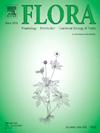High-resolution characterization of rhizosphere oxygen (O2) dynamics in different wetland plant species after light/dark transitions
IF 1.7
4区 生物学
Q3 ECOLOGY
引用次数: 0
Abstract
Radial oxygen loss (ROL) is crucial for wetland plant survival and interactions with rhizosphere microenvironments. The ubiquitous presence of light/dark transitions can significantly influence ROL function by regulating photosynthetic activity; however, overall magnitude and direction of these effects are unclear. Herein, high-resolution planar O2 optodes were employed to quantify the O2 dynamics around the roots of three typical wetland plant species during light/dark transitions. The 2D and 1D O2 distributions confirmed that ROL activity was heterogeneously distributed, with millimeter-wide zones of intense leakage around the roots of all three plants. Significant species-specific variations in root-derived O2 leakage capacity during light/dark transitions were also observed. Specifically, the average O2 concentrations declined by ca. 10.2%, 23.9%, and 17.0%, respectively, for Oryza sativa, Vallisneria spiralis, and Acorus calamus upon switching from light to darkness. In comparison, the oxic microzone area around their roots decreased by 23.03%, 7.21%, and 13.67%. Correspondingly, the ROL rates showed a pronounced decrease from light to darkness, dropping in O. sativa by 14%, in V. spiralis by 23%, and in A. calamus by 25%. Acorus calamus has the highest ROL capacity, which was likely facilitated by its well-developed lacunar system and efficient O2 transport. Additionally, our results directly support the existence of oxic microzones and continuous O2 release throughout light/dark transitions; this could guarantee that a continuous oxic environment surrounds the roots and shields plants from anaerobic phytotoxins in the rhizosphere. The passive diffusion of O2 from the air or water column in total darkness may be the primary source of the modest aerobic sphere that surrounded each root. This study advances our understanding of the complex interplay between photosynthesis and ROL, contributing new insights into plant–sediment interactions and adaptive strategies of wetland plants to environmental fluctuations.
求助全文
约1分钟内获得全文
求助全文
来源期刊

Flora
生物-植物科学
CiteScore
3.30
自引率
10.50%
发文量
130
审稿时长
54 days
期刊介绍:
FLORA publishes original contributions and review articles on plant structure (morphology and anatomy), plant distribution (incl. phylogeography) and plant functional ecology (ecophysiology, population ecology and population genetics, organismic interactions, community ecology, ecosystem ecology). Manuscripts (both original and review articles) on a single topic can be compiled in Special Issues, for which suggestions are welcome.
FLORA, the scientific botanical journal with the longest uninterrupted publication sequence (since 1818), considers manuscripts in the above areas which appeal a broad scientific and international readership. Manuscripts focused on floristics and vegetation science will only be considered if they exceed the pure descriptive approach and have relevance for interpreting plant morphology, distribution or ecology. Manuscripts whose content is restricted to purely systematic and nomenclature matters, to geobotanical aspects of only local interest, to pure applications in agri-, horti- or silviculture and pharmacology, and experimental studies dealing exclusively with investigations at the cellular and subcellular level will not be accepted. Manuscripts dealing with comparative and evolutionary aspects of morphology, anatomy and development are welcome.
 求助内容:
求助内容: 应助结果提醒方式:
应助结果提醒方式:


